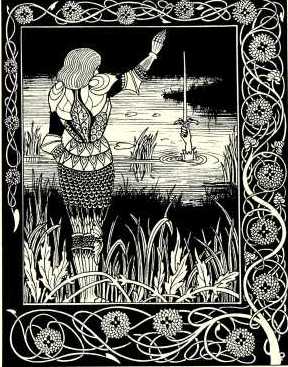
Image Credit:
Aubrey Beardsley
When I was getting my B.A. at the University of British Columbia in the early 2000's, the English professors there assigned primary text readings almost exclusively. There are things to recommend this approach, but one result was that students were left to discover and master literary criticism, theory, and history (or not) on their own. Professors used their expertise to fill in the blanks and keep class discussions focused and productive, but a lot of my papers were kind of unfocused and wandering. When I got to grad school, I quickly came to understand that tendency to wander as a lack of critical framework and self-consciousnesses of methodology.
So, when I finally got to teach literature, I was really interested in getting my students invested in the idea of using secondary materials to create critical frameworks that would allow them to see things in the primary text that they would otherwise have missed. As it turned out, I was dogged and lucky enough to secure myself a teaching assignment that raised a lot of eyebrows. I was to teach an introductory lit course entitled simply "A Game of Thrones." I mentioned to the powers that be that since I'd actually be teaching both the novel A Game of Thrones and its sequel A Clash of Kings, and would not be referring at all to the HBO series Game of Thrones, that the course title should be A Song of Ice and Fire, but the powers that be didn't really care.
It didn't matter, either. As my class filled out, I filled out my reading list, and decided that I wanted to introduce a basic notion of the aesthetic and thematic rules of thumb for the books. The idea was that if my students had that common ground to work from, the class discussions and, by extension, their written work, would have a kind of critical framework that would productively direct attention to significant moments in the text. In class, the next step would be to unpack those moments with the analytical tactics of close reading. In papers, students could use those habits of mind to direct their own research and interpretive synthesis.
So I'm a medievalist, and 14th-century English romances figure prominently in my dissertation. As a result, I've come to view the five currently extant volumes of A Song of Ice and Fire not so much as a series, but as a cycle, in the manner of Malory's great compendiums of Arthuriana. This observation, which was long a source of private, nerdy enjoyment for me, led me as a teacher to Eugene Vinaver's two groundbreaking essays on medieval literary aesthetics, "The Poetry of Interlace" and "Analogy as the Dominant Form." Without going into too much detail, Vinaver argues that romance cycles have these two features as the operative center of their aesthetics. So in romance, enjoyment is created and thematic meaning is established on the one hand by the analogy of disparate persons and events, which reflect and distort each other in meaningful ways; and on the other by entrelacement, the interweaving of seperate but related adventures or narratives, whose course spans the whole cycle, whose whole unfolding we do not see because as one narrative strand is foregrounded, the others are backgrounded, in a continuous interweaving pattern. The novel's "plot arc" is an irrelevancy in romance: one is better off imagining something more like a celtic knot design.
If you've read ASoIaF, this aesthetics should sound familiar, which is weird since it was published in the '50's and meant to describe literature published in the 1490's. Nevertheless, I assigned these two essays in the first three weeks of class and have been stunned by how often, in class and in writing, my students have referred to Vinaver's arguments, and the essays I've been grading have been startling in their evidentiary scope and incisiveness of argument.
The conclusion: assigning criticism is good, in moderation. Even if you're setting out to teach close reading practices, pick the one or two essays that best suit or describe or speak to a text, and encourage your students to apply criticism ... well, critically. It's just like food and wine. When you have the right pairing, the experience becomes more than the sum of its parts.

